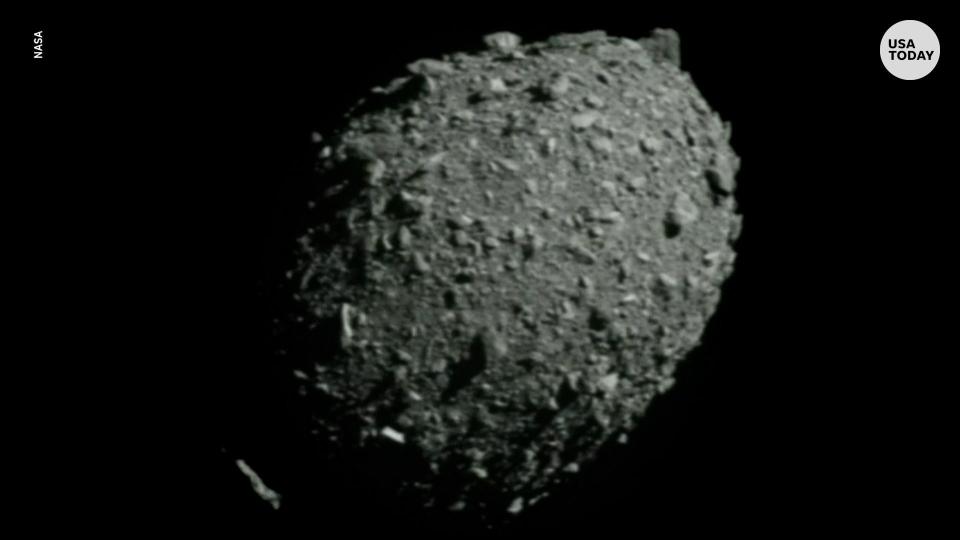NASA's DART outperforms against asteroid; lunar eclipse aligns on Election Day | Sky Guy
- Oops!Something went wrong.Please try again later.
NASA’s DART mission was a smash hit – literally. Last month I wrote about NASA’s Double Asteroid Redirection Test smashing into the asteroid Dimorphos.
DART was the first planetary defense demonstration to see if we could successfully change the orbit of an incoming object. “At its core, DART represents an unprecedented success for planetary defense, but it is also a mission of unity with a real benefit for all humanity,” said NASA Administrator Bill Nelson.
The Sky Guy: Starlink sightings, Neptune's rings and Artemis keep focus on space | The Sky Guy
Competition: Tallahassee student — and his blacksmith forge — to compete for $25,000 prize
Things to do in Tallahassee: Hop on the Ferris wheel or catch a food festival
The results of that hit are in and they are way more than expected. NASA had hoped to change the orbital period of Dimorphos by at least 73 seconds. The initial data shows that DART passed this minimum by more than 25 times. It changed the orbit by 32 minutes.

“All of us have a responsibility to protect our home planet. After all, it’s the only one we have,” said NASA Administrator Bill Nelson. “This mission shows that NASA is trying to be ready for whatever the universe throws at us.”
Hopefully we won’t have to use this knowledge.
Total lunar eclipse on Election Day
There will be a total lunar eclipse in the early morning hours on Nov. 8 (Election Day). A partial eclipse will begin at 4:08 a.m. with totality following at 5:16 a.m. and running through 5:42 a.m.
The moon will set shortly after while being partially eclipsed. So find a location with a clear western view and enjoy this unique event.
Voting: Early voting in Florida ends Saturday, except where it doesn't. Check your county here
Morning sky: You can see Mars in the early morning sky. It will be a little west of overhead just before sunrise. Look for a bright, reddish “star” straight up. Watch the Moon pass a couple of bright stars and planets, see below for dates.
Evening sky: Jupiter entered the evening sky last month joining Saturn. Brilliant Jupiter will be in the east just after sunset and Saturn is about halfway up. While Saturn is not that bright, it is in an area with no bright stars so it’s easy to find. Watch the Moon pass a couple of bright stars and planets, see below for dates.
5th: Tallahassee Astronomical Society’s free planetarium show, “November Skies over Tallahassee,” at the Downtown Digital Dome Theatre and Planetarium at the Challenger Learning Center (not recommended for children under 5). Doors close at 10 a.m. sharp. Masks highly recommended.
Daylight saving time 2022: U.S. Senate OK'd Sunshine Protection Act, but Florida will still fall back, for now
6th: Daylight-saving time ends: 2 a.m. “falls back” to 1 a.m.
8th: Total lunar eclipse in the early morning (see above for details).
9th: Moon near the Pleiades star cluster in the morning sky.
11th: Moon near Mars in the morning sky.
13th: Moon forms a line with the bright stars Castor and Pollux in Gemini in the morning sky.
17th: Moon near the bright star Regulus in Leo in the morning sky.
18th: Leonid meteor shower peaks.
21st: Moon near the bright star Spica in Virgo in the morning sky.
28th: Moon near Saturn low in the west in the evening sky.
Check out TAS’s events calendar at tallystargazers.org.
Ken Kopczynski is president of the Tallahassee Astronomical Society, a local group of amateur astronomers.
Never miss a story: Subscribe to the Tallahassee Democrat using the link at the top of the page.
This article originally appeared on Tallahassee Democrat: DART is hit; lunar eclipse is on the way; time to fall back on Nov. 6

